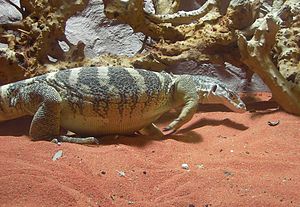Spencer's monitor lizard
| Spencer's monitor lizard | ||||||||||||
|---|---|---|---|---|---|---|---|---|---|---|---|---|

Spencer's monitor lizard ( Varanus spenceri ) |
||||||||||||
| Systematics | ||||||||||||
|
||||||||||||
| Scientific name | ||||||||||||
| Varanus spenceri | ||||||||||||
| Lucas & Frost , 1903 |
Spencer's monitor lizard or Spencer's monitor lizard ( Varanus spenceri ) is a species of scale reptiles from the genus of monitor lizards ( Varanus ) that is endemic to Australia . It belongs to the subgenus Varanus . It was first described in 1903 by Lucas & Frost. In English the art is called Spencer's goanna or Spencer's monitor.
Appearance and build
Spencer's monitor lizard is up to 120 cm long when fully grown. The tail length is on average longer than the head-trunk length. Their usual basic color is light gray-brown, but the range goes from pale-dirty-cream-colored to a dark rust-brown, with scattered dark-brown and cream-colored spots. But there can also be spots and irregular, narrow, light yellow or gray transverse bands on the back, neck and tail. There are distinct light and dark stripes on the lips . Their background is cream-colored with dark gray or brown spots that are particularly clearly visible on the throat . The head scales of Spencer's monitor lizard are smooth and irregularly arranged. The nostril is on the side, where it is much closer to the tip of the snout than to the eye. There are 150-175 rows of scales around the middle of the body. Their tail cross-section is round at the base. The last half of the tail is compressed laterally and has a double central keel . Spencer's monitor lizard is usually heavier than similar sized monitor lizard of other species due to their stocky build . They have sharp claws at the ends of their four limbs that they use to dig holes.
distribution and habitat
The distribution area of Spencer's monitor lizard extends in Australia to the dry plains in the northeast of the Northern Territory up to the border to Queensland . The monitor lizards are endemic to the Barkly region . It is only found in areas with black earth. In the wide, treeless plains, the species lives in caves or between large crevices . Most of the sightings were in the Barkly Tablelands (Northern Territory) and the Tablelands Highway (Queensland). They live in the Australian national parks Astrebla Downs National Park ( Qu ) and in the Diamantina National Park ( Qu ). These monitor lizards live in captivity, for example in the Cologne Zoo .
behavior
The monitor lizards only catch prey in the morning and late afternoon when the temperatures are cooler. They eat everything they can find, including highly poisonous snakes , small mammals , small lizards , eggs and carrion . They are able to digest everything they eat. When you feel threatened, hiss loudly and stretch your neck to appear taller. If warning is not enough, they whip the attacker with their muscular tail . They are also able to effectively defend themselves against people with their tails. In contrast to the adult specimens, the young animals can occasionally climb.
According to Schmida (1985), adult monitor lizards are said to be most sexually active between August and October. Pengilley (1981) sighted a large number of females in late September and early October looking for nesting sites. They laid their eggs under a pile of dirt. A female captured in the wild laid her eggs in early November. The clutch of Spencer's monitor lizard has between 11 and 31 eggs. The eggs are 5 cm long and 3.5 cm in diameter.
literature
- JENKINS, RWG & COGGER, HG (1986) Varanidae. in: DOLLINFER, P. (ed.1985) Reptilia - Amphibia - Pisces. CITEWS Identification Manual Vol. 3. Lausanne.
- ROTTER, J. (1963) The monitor lizards. The Neue Brehm Library, Vol. 325. A. Ziemsen Verlag, Wittenberg Lutherstadt.
- NEUGEBAUER, W. (1970) Grzimek's Animal Life Volume 6: Reptiles. Kindler Verlag Zurich. Licensed edition of Deutscher Taschenbuch Verlag GmbH, Munich, 1980. ISBN 3-423-03204-9 .
- Pengilley, R. 1981. Notes on the biology of Varanus spenceri and V. gouldii, Barkly Tablelands, Northern Territory. Australian Journal of Herpetology 1: 23-26.
- Cogger, HG 2000. Reptiles and Amphibians of Australia, 6th ed. Ralph Curtis Publishing, Sanibel Island, 808 pp.
- Boulenger, GA 1906. Description of a new lizard and snake from Australia. Ann. Mag. Nat. Hist. (7) 18: 440-441
- Wilson, S. & Swan, G. 2010. A Complete Guide to Reptiles of Australia, 3rd Ed. Chatswood: New Holland, 558 pp.
Web links
- Varanus spenceri in The Reptile Database
- Spencer's monitor lizard on varanidae.org
- Spencer's monitor lizard on mampam.com
- Spencer's Waran on monitor-lizards.net ( English )
- Spencer's Waran on waranwelt.de
- Spencer's Waran on monitor-lizards.net
- Spencer's monitor lizard on kingsnake.com ( pictures )
Individual evidence
- ↑ waranwelt.de ( Memento of the original from August 8, 2014 in the Internet Archive ) Info: The archive link was inserted automatically and has not yet been checked. Please check the original and archive link according to the instructions and then remove this notice.
- ↑ worldwildlife.org
- ^ Notes on the Biology of Varanus Spenceri and V. gouldii, Barkly Tablelands, Northern Territory
- ↑ arod.com.au
- ↑ http://www.arod.com.au/arod/index.php?q=park%3D%22Astrebla+Downs+National+Park%22
- ↑ http://www.arod.com.au/arod/index.php?q=park%3D%22Diamantina+National+Park%22
- ↑ Video on Youtube: Spencer's monitor lizard in Cologne Zoo ( video )
- ↑ koelnerzoo.de/ pdf ( Memento of the original from March 4, 2016 in the Internet Archive ) Info: The archive link was inserted automatically and has not yet been checked. Please check the original and archive link according to the instructions and then remove this notice. /
- ↑ zoodirektoren.de
- ↑ This behavior is described in the literatures of MERTENS 1942d, 1958, KEAST 1959, WORRELL 1966, BUSTARD 1968, SWANSON 1976, PENGILLEY 1981, WILSON & KNOWLES 1988, HOSER 1989, COGGER 1992, EHMANN 1992
- ↑ reproductive described mampam.com